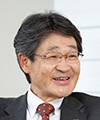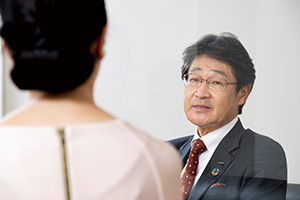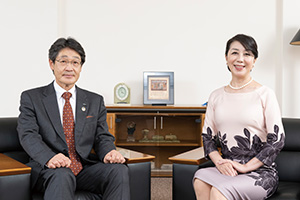 |
|
|
|
|
|
View from the Top Vol. 20, No. 11, pp. 1–5, Nov. 2022. https://doi.org/10.53829/ntr202211tp1
Think Big, Start Small with High Aspirations and PassionAbstractIt has been over half a century since the Data Communications Division was established within the Nippon Telegraph and Telephone Public Corporation (now NTT) in 1967, which was spun off as NTT DATA in 1988. NTT DATA has earned the trust of many of its clients by understanding their business operations and using its technology to create and operate new systems that support society. We interviewed Yo Honma, president and chief executive officer of NTT DATA, who is leading the company’s transformation while maintaining long-term relationships with clients, about the business environment surrounding NTT DATA and his thoughts as a top executive. Keywords: digital transformation, profitable global growth, sustainability Pursuing profitable global growth through consistent belief and courage to change—First, would you tell us about the business environment surrounding NTT DATA? We have been striving to expand our business globally since FY2005. After executing the so-called Global 1st and 2nd Stages of this effort, we are currently implementing the Global 3rd Stage under which we aim to obtain the top-five status in net sales among the global information technology (IT) services industry by around FY2025 and become a global company trusted by clients worldwide. As the preliminary step of this stage, during the previous medium-term management plan from FY2019 to FY2021, we pursued profitable growth on a global scale with consistent belief and courage to change. We have worked with many clients to construct IT systems that support their business and contributed to society. We will continue to maintain and nurture our long-term relationships of trust with our clients as our consistent belief. At the same time, we are thoroughly committed to making a solid profit and investing it in forward-looking projects. Outside Japan, we have carried out restructuring of our business, which resulted in expanding it through global offerings and acquisition of various digital businesses in each region. These were achieved through our courage to change. We achieved three of our four business goals in FY2021; consolidated net sales of 2.5-trillion yen, a client base of more than 80 companies, and consolidated operating income margin of 8%. Although an EBITA (earnings before interest, taxes, depreciation, and amortization) margin of 6.5% did not quite meet the target goal of 7%, partly due to the impact of the COVID-19 pandemic, we achieved 7% in North America. During the previous medium-term management plan, our business was greatly affected by the COVID-19 pandemic. We can say that our business-to-business business, which is the core of our business, faced two “winds”: a head wind and a following wind. First, clients in the transportation, travel, and service industries faced a difficult environment and curtailed their IT investments. That is the head wind we faced. Many clients wanted to reduce costs of system maintenance and operations. We have been responding to those client demands by transforming the way we work to further automate operations, increase productivity, and speed up development. Second, in accordance with the desire to build a new society, the trend to create new services, products, and business models by using IT and digital technologies has accelerated. We have been striving to harness this following wind and turn it into an opportunity for growth.
Supporting the growth of our clients°« businesses and working together with them to build a sustainable future—It’s great to be able to achieve your goals even in the COVID-19 pandemic. What strategies will be deployed in the new medium-term management plan? Although we have almost achieved the business goals set out in our previous medium-term management plan, we must aim even higher to accomplish the Global 3rd Stage. Our new medium-term management plan (for FY2022 to FY2025) announced in May 2022 further advances the principles set out in our previous medium-term management plan. As I mentioned earlier, the purpose of IT investment is shifting from digitizing a company’s existing operations to creating new services and business models through IT and digital technologies. Digital transformation to solve social issues and help preserve the global environment is also gaining pace. Various players are also expanding their service offerings in response to changes in society and technology, further intensifying competition. Under such circumstances, we must further strengthen our competitiveness. Therefore, we will continue to pursue profitable global growth and further expand digital offerings. Companies are witnessing a shortage of IT personnel and engineers worldwide. It is no exaggeration to say that our business is all about human resources, so it is vital to enhance the capabilities of our employees and organization as a whole. Under our new medium-term management plan, we also need to enhance the two strengths we have cultivated thus far to support growth of our clients’ businesses and creating a sustainable future together with our clients and become a trusted global innovator. One strength is the ability to create systems while understanding our clients and using our advanced technical capabilities. The other strength is the ability to connect people, companies, and society by supporting various enterprise systems and social infrastructure. The objective of our clients had been to replace existing business and social systems with IT systems, so how to create highly reliable systems had been our key theme. From now on, however, our clients will be required to create new services, products, and business models by using IT and digital technologies, and what to create is becoming the more important theme. To meet the needs of the times, we will strengthen our consulting capabilities on the basis of foresight that looks beyond the client’s industry and collaborate with clients to create new services and business models. Of course, the architecture for creating such services and business models is also important. Our strength will be our ability to propose what is feasible by leveraging our advanced knowledge and technology. Recent situation, such as climate change and the COVID-19 pandemic, have highlighted many social problems. The key to solving these problems is to use IT and digital technologies. We want to contribute to solving social problems through the digitization of society as a whole by enhancing not only our digital capabilities but also that of our partner companies and clients. Therefore, in our new medium-term management plan, we have positioned ourselves more clearly to contribute to solving social issues through our business activities under the slogan of “Realizing a Sustainable Future.”
—So your new medium-term management plan focuses on supporting clients, partners, and the industry and solving social problems, right? Since 1967, for more than 55 years, when NTT DATA’s predecessor, the Data Communications Division, was established at the Nippon Telegraph and Telephone Public Corporation (now NTT), we have approached our business with an attitude focusing on benefiting society. The corporate mission of NTT DATA is “to use information technology to create new paradigms and values, which help contribute to a more affluent and harmonious society.” With this mission, which has been passed down from generation to generation, in mind and by nurturing the long-term relationships that we value, we will work in harmony with our clients to build the society of the future. In the current era of the Internet of Everything, all people and things are becoming connected through the advancement of digitalization. Some data are collected from the edge, while other data are collected from smartphones and other devices, which include consumer-contact data. Securely collecting, analyzing, and using data, which is often referred to as “the oil of the 21st century,” beyond the boundaries of companies and industries will make it possible to address complex social issues. To make such data distribution and utilization a reality, it is necessary to be able to handle such a massive amount of data with high reliability, and the NTT Group’s Innovative Optical and Wireless Network (IOWN) is expected to meet this requirement. NTT DATA established the IOWN Promotion Office in January 2021 with the aim of understanding social trends and client needs, verifying the component technologies of IOWN, and promoting implementation of IOWN. We are focusing on a data-collaboration platform and Digital Twin Computing to envision and build a digital-twin platform that will be used across a wide variety of industries and business sectors for digital transformation of society. The NTT Group is also working in unison to achieve its environmental and energy vision “NTT Green Innovation toward 2040.” NTT DATA’s green innovation initiatives are based on two pillars: “Green Innovation of IT” to reduce our greenhouse gas (GHG) emissions, and “Green Innovation by IT” to reduce GHG emissions of our clients and society as a whole through our business activities. Regarding “Green Innovation of IT,” we aim to achieve the science-based target of reducing GHG emissions by 60% by FY2030 compared with the FY2016 level. Approximately 70% of our electricity consumption is accounted for by the datacenters we run. By introducing innovative cooling and air-conditioning technologies and advanced IT technologies, we plan to replace all electricity used in our datacenters with renewable energy by 2030. We also aim to become carbon neutral in terms of Scope 1 (direct emissions from resources owned or controlled by the company) and Scope 2 (indirect emissions from the purchased energy) by 2040 and net zero (which includes Scope 3 (indirect emissions in the supply chain)) by 2050. Regarding “Green Innovation by IT,” we will contribute to reducing emissions through the systems and services we provide. For example, Trade Waltz, a trade-information collaboration platform, digitizes trade administrative work such as contracts, settlements, and customs clearance, which used to be mostly paper based. This platform contributes to not only improved work efficiency and cost reduction but also conservation of forests and reduction of carbon dioxide (CO2) emissions. We estimate that if all players involved in Japan’s trade practices used Trade Waltz, up to 30,800 trees could be conserved and 431 tons of CO2 could be reduced annually.
Focusing on the creation of strength, creation of value, and development of human resources—What did you experience to reach your current position? I joined the Nippon Telegraph and Telephone Public Corporation in 1980. Back then, Yasusada Kitahara, the vice-president of Nippon Telegraph and Telephone Public Corporation, launched a concept called the information network system (INS). Attracting attention from around the world, the INS aimed to digitize and integrate all communication networks and provide various services, such as telephone, data communication, and image communication, through an integrated network. After reading the book explaining the concept, I thought a job working on the INS sounded interesting, so I was inspired to join the company. My 40 years at NTT has been a daily joy, although sometimes a struggle. Our system-development work is project based, so both joys and hardships are shared among the project team members. When the job is completed, everyone hugs and pats each other on the back. That joy is unmatched by anything else. The saying, “All for one and one for all” is a very important spirit to have. We also share hardships and joys with our clients. One of the most impressive projects I had ever been involved in was one to develop a travel-industry system. We were unfamiliar with the travel industry, and the project was becoming problematic. We first tried our best to keep things running smoothly, but over time, the project team members became exhausted. Talented people could be assigned to solve problems, but that approach can lead to the loss of new business opportunities. With that in mind, we explained our situation to the client and asked for their cooperation in making the project a success. In fact, this simple act is extremely important. Things do not work well in a typical relationship between a contractor and contractee; it is important to recognize that we and our clients are in the same boat and that cooperating with each other leads to the success of the project and great satisfaction when it is completed. Therefore, I have always valued the power of organization, where we work together as one team, on the same footing, to create something good together. A good organization cannot be established solely on the capabilities of individuals. NTT DATA attracts exceptional people, and combining their strengths with the vitality that pervades the organization, attractiveness of the work, attractiveness of the upper management and colleagues, and attraction that both clients and we feel for each other can lead to good results. Organizational strength can be represented as the multiplication of strength, vitality, and attractiveness. Using other words to make a similar point, I can say “skill” and “will” are necessary to produce good results. Skill is very important, but it is not enough; will is also important. Combining skills and will with teamwork will produce outstanding results. Regarding the travel-industry project I mentioned, the project manager bought vellum paper and ribbons from a store next to the head office and used it to visualize the progress of the project and facilitate discussions, which created a positive mood in the team and increased the collective strength of the team. —Listening to you, I get the impression that you have always had a comprehensive view of things. What do you think it is important as a top executive? I have been working with clients while keeping the importance of our long-term relationships in mind. Long-term relationships with clients go through good times and bad times; all the same, it is extremely important to do one’s best for the client even when times are tough. Clients look closely at our work and say, “You’ve gone this far, and you’ve thought that far?” That recognition leads to trust. To maintain that trust, I place importance on thoroughness in all I do. I will continue to value the attitude of being thorough in what I decide to do, even in the most mundane matters. I also place importance on creation of strength, creation of value, and development of human resources. In particular, the various laboratories of NTT have their own areas of expertise. By combining such expertise with our value, I’d like to provide our clients with better services. Finally, I believe that top executives must approach their work with an attitude of think big and start small, high aspirations, and passion. However, even if you have a strong will and clear vision, you will face ups and downs along the way. You might even encounter an unimaginable event. I think it is vital that top executives have the ability to stay on course and move forward, even when their team faces difficult situations. In this day and age, we have no clear charts to navigate the ocean that is the business world. Still, top executives must have a compass to provide guidelines even in a changing environment. Interviewee profileCareer highlightsYo Honma joined Nippon Telegraph and Telephone Public Corporation in 1980. In his career at NTT DATA Corporation, he became executive vice president and general manager of the Third Enterprise Business Division in 2013, director and executive vice president, head of the Enterprise IT Segment in 2014, and representative director and senior executive vice president in 2016. He assumed his current position in June 2018. |




